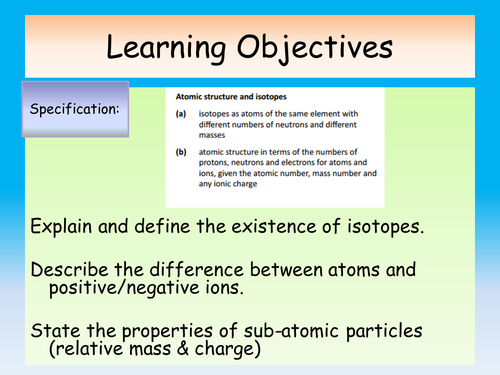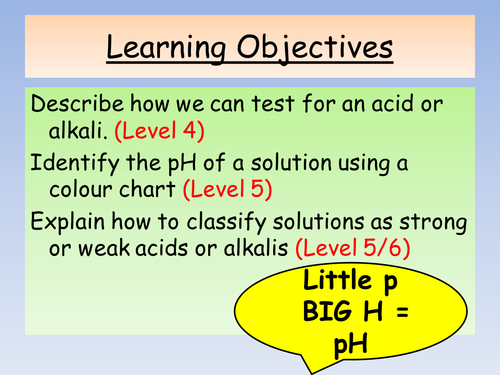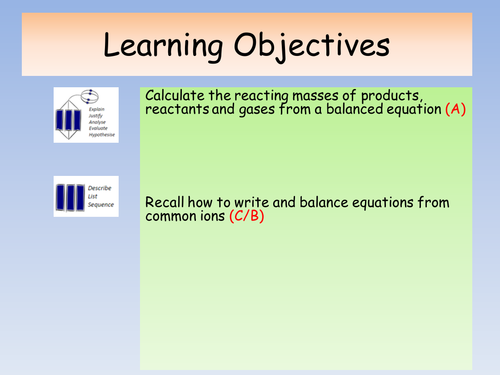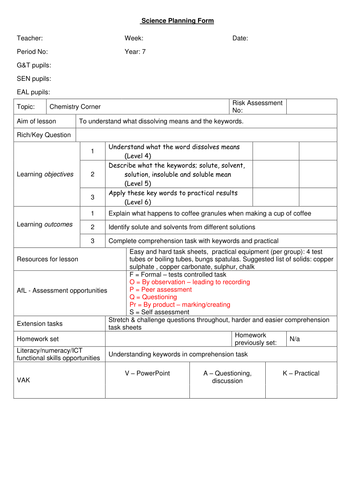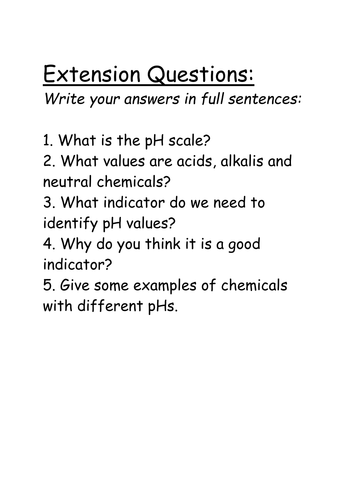
50Uploads
22k+Views
8k+Downloads
All resources

OCR A Level Chemistry A New Spec (from Sept 2015) - Atoms intro lesson
First lesson I use as an introduction to A Level Chemistry as part of Module 2 - Foundations of Chemistry.
It is a great group based lesson to encourage discussion about recapping ideas from GCSE including:
Labelling an atom
Atomic numbers
Numbers of sub-atomic particles in atoms and ions
Isotopes

Chemistry Corner KS3 Year 7 Topic - Acids and Alkalis
This is the sixth lesson in a topic I made called Chemistry Corner for KS3 Year 7.
This lesson includes a powerpoint on what an acid and alkali are, pH scale, testing a circus of liquids
and recording results, extension questions and a homework sheet on acids and alkalis.
This scheme of work was made when KS3 Levels were used, so you may need to amend the levels according to your own assessment criteria used for KS3.

Chemistry Corner KS3 Year 7 Topic - Making indicator
This is the seventh lesson in a topic I made called Chemistry Corner for KS3 Year 7.
This lesson includes a powerpoint on a high five review task for acids and alkalis, making indicator from red cabbage, testing red cabbage indicator to identify whether a mystery solution is an acid or alkali.
This scheme of work was made when KS3 Levels were used, so you may need to amend the levels according to your own assessment criteria used for KS3.

Chemistry Corner KS3 Year 7 Topic - Filtering
This is the tenth lesson in a topic I made called Chemistry Corner for KS3 Year 7.
This lesson includes a powerpoint reviewing solvent, solute and solution from the previous lesson, introducing the key words filtrate and residue, mini plenary assessment worksheet and a desert island practical problem using filter paper and labelling a filtration practical.
This scheme of work was made when KS3 Levels were used, so you may need to amend the levels according to your own assessment criteria used for KS3.

OCR A Level Chemistry A New Spec (from Sept 2015) - Stoichiometry, yield and atom economy lessons
These are lessons 7 and 8 in the Amount of Substance topic in Module 2- Foundations in Chemistry.
The Stoichiometry powerpoint covers how to use the molar ratio to calculate an unknown and various examples using the equations taught in the topic so far with various degrees of difficulty and answers. I often mount these onto card with the answers underneath around the room to encourage discussion and group work.
The yield and atom economy powerpoint covers how to work out % yield and atom economy calculations as well as comparing the difference and which is more favourable.

New OCR A Level Chemistry Specification Lesson - Properties of Alcohols
This powerpoint covers properties of alcohols which would take one lesson's worth of content. The powerpoint covers:
Boiling point, Solubility and Volatility linked to hydrogen bonding of alcohols
Graph drawing task to illustrate BP of alcohols vs alkanes
Classifying alcohols into primary, secondary and tertiary alcohols
Snap plenary task for alcohols.

Chemistry Corner KS3 Year 7 Topic - Dissolving
This is the ninth lesson in a topic I made called Chemistry Corner for KS3 Year 7.
This lesson includes a powerpoint on what dissolving means and explanations about key words solvent, solute and solution, a dissolving practical, comprehension tasks reviewing the lesson and key words (differentiated options for the task)
This scheme of work was made when KS3 Levels were used, so you may need to amend the levels according to your own assessment criteria used for KS3.

OCR A Level Chemistry A New Spec (from Sept 2015) - Electronegativity and IMF lessons
This is lesson 5 and 6 in the Electrons, bonding and structure topic in Module 2 - Foundations in Chemistry.
There is enough content here to easily last 2-4 lessons depending on the ability of the class!
The powerpoint starts off with a bonding pop quiz to test their recall of drawing shapes, names and bond angles then goes onto electronegativity, polar and non polar bonds.
The following lesson then covers London forces, permanent dipole-dipole and hydrogen bonding and applying this to properties of water. There is also an AfL task which I set the students at the end to consolidate their understanding of intermolecular forces and looking at case studies of iodine, water and DNA.

Chemistry Corner KS3 Year 7 Topic - Lessons 6-11
This bundle is for half of the topic (Lessons 6-11) as there are too many resources for me to upload the whole topic as a bundle, so I'm having to sell them as two separate bundles.
Lessons 6-11 cover:
Acids & Alkalis
Making your own indicator
Neutralisation reactions
Dissolving
Filtering
Evaporation
This scheme of work was made when KS3 Levels were used, so you may need to amend the levels according to your own assessment criteria used for KS3.

Chemistry Corner KS3 Year 7 Topic - Lessons 1-5
This bundle is for half of the topic I made for KS3 Year 7 called Chemistry Corner (I could only upload half of the lessons so this is for half of the topic, as there are so many resources I've had to split them into two bundles!)
The first five lessons cover:
Solids, liquids and gases
Changes of state
Properties of metals
Simple Chemical reactions
Acids and Alkalis
This scheme of work was made when KS3 Levels were used, so you may need to amend the levels according to your own assessment criteria used for KS3.

